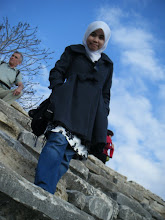Assalamualaikum wrt wbt.
Jom telaah genitourinary system plak arini.
HISTORY TAKING
PRESENTING COMPLAINT
1. Change in urinary appearance (haematuria,haemoglobinuria,drugs)
-any blood in your urine?
-frank blood/change in colour 'tea-coloured' urine?
-notice blood in early/late in urinary stream?
*late in the stream :kidney/bladder tumour,bleeding from prostate,calculi,infection
2. Change in urinary volume
-polyuria (>3L/day) : acute renal failure
-oligouria (<400ml/day) : renal failure/dehydration
-anuria (<50ml/day)
3. Urinary obstruction (prostatism)
-Hesitancy
-Nocturia
-Poor stream
-Terminal dribbling
-Incomplete emptying
-Increase frequency
-Incontinence
-Retention : inability to pass urine
4. Renal pain
-pyelonephritis : associated with fever,rigors
-renal cell carcinoma : dull/constant pain at renal angle
-renal stone/calculi : severe pain
5. Prostitis (inflammation of prostate)
-ask SRCOPDSARA
6. Incontinence
-stress incontinence : when sneezing,cough
-urgency; strong desire followed by incontinence
-overflow incontinence
-spinal cord lesion -look for catheter
7. Pneumaturia (bubbles in the urine)
-due to vesico-uteric fistula : Crohn's disease
8.Renal failure
-anuria
-oligouria
-nocturia
-anorexia/vomit/fatique/hiccup (uraemia)
-pruritis -itchy skin
-oedema -fluid retention
-hyperkalaemia :muscle weakness, arrhythmia
-bone pain -renal osteodystrophy
-anemia
-altered consciousness
-dyspnoea -pleural effusion,cardiac failure
PAST MEDICAL/SURGICAL HISTORY
-History of reccurent UTI/calculi
-Previous haematuria/proteinuria
-History of diabetes/gout
-Hypertension!
-Renal biopsy
-Childhood UTI
MEDICATIONS
-aminoglucosides,rifampicins,NSAIDS,immunosuppressant
-prescribed/over-the-counter drugs
ALLERGIES
-to any medication
SOCIAL HISTORY
-marital status
-employment
-alcohols (units)
-smoking history (pack per year)
-how they cope if dialysis? who's at home with them?
FAMILY HISTORY
-inherited renal disease : polycystic kidney disease (AD)
-relevant family hx : hypertension,diabetes
MUST KNOW QUESTIONS!
*Urinary obstruction (HITS) -benign prostatic hyperplasia(BPH)
-Hesitancy : problem starting to pass water
-Intermittency : stop in the middle of micturation
-Terminal dribbling
-Stream : 'How's ur stream?' 'Can u hit the wall'
* Irritative storage (NIFU)
-Nocturia : 'how often u wake up in the middle of the night to pass water?'
-Incontinence
-Frequency : go to toilet more often than usual to pass water without increase in volume.
-Urgency : strong desire to pass urine
* Urinary tract infection
-frequency
-dysuria : painful micturation
-fever
-loin pain
-haematuria :blood in urine
RENAL TRANSPLANT
*About renal transplant
-how's the current function?
-any renal transplant before?
-any rejection episode?
-complication of drugs (immunosuppressive)
*Sexual problem (male)
-lack of libido
-penile discharge
*Sexual problem (female)
-frequency, regularity, duration of menses
-blood loss
-dysmenorrhea
-post menopausal/coital (intercourse) bleeding
-OCP/HRT
-vaginal discharge
PHYSICAL EXAM GU
1. General inspection
-alert? -toxic retention
-anaemia : 'the skin colour is good/looks pale'
-shallow complexion : clue for chronic renal failure
-hydration : 'the patient is well-hydrated'
-hyperventilation :clue to metabolic acidosis
-hiccup :terminal uraemia
2. Hands
-Leuconykia : nephrotic syndrome (hypoalbuminaemia)
-Terry's line (20% renal failure px)
-Palmar creases pallor (anaemia)
-Asterixis
3. Arms
-AV fistula
-bruising
-scratch mark
-skin pigmentation
-BP
4. Face
-conjunctival pallor : anaemia
-jaundice :nitrogen retention can cause haemolysis
-uraemic fetor : breakdown of urea to ammonia in saliva
-mucosal ulcers : underlying CTD
-rash
-gingival hyperplasia : immunosuppressive drug
gingival hyperplasia
5. Neck
-central line (double-lumen tunnel cuffed catheter : dialysis)
-raised JVP
-carotid bruit
6. Chest
-cardiac : CCF,HTN,pericarditis
-Lung : pulmunary oedema, infection
7. Abdominal exam
7.1 Inspection
-nephrectomy scar (loin+lumbar region)
-nephrectomy tube
-renal transplant scar (RIF/LIF)
-transplanted kidney (bulge under the scars)
-Catheter : peritoneal dialysis
-Small scar : catheter placement
-Distension : ascites,PKD,dialysis fluid
7.2 Palpation
-kidney :bimanual method
-transplanted kidney : RIF/LIF
-hepatomegaly
-distended bladder (suprapubic) -regular,smooth,firm,oval shaped
7.3 Percussion
-Ascites : shifting dullness, fluid thrill
-Enlarged bladder
7.4 Auscultation
-renal bruit :renal artery stenosis due to artherosclerosis
8. The back
-sacral oedema :fluid overload/CCF
-bony tenderness : renal osteodystrophy
9. The legs
-oedema
-pigmentation
-scratch marks
-gouty tophi
-peripheral neuropathy
Ideally, i would like to complete my examination by doing digital rectal examination and urine dipstick.
RENAL MASS! (ABCH)
-Abscess/acute pyelonephritis
-'Big cyst' -polycystic kidney disease (PKD)
-Carcinoma
-Hydronephrosis


